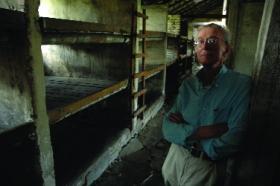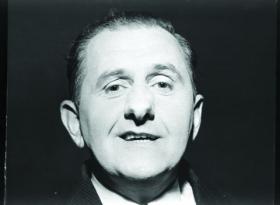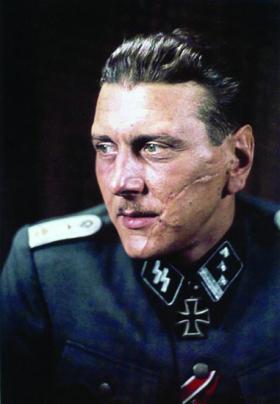TV Eye: Ireland’s Nazis
Published in 20th-century / Contemporary History, Issue 2 (Mar/Apr 2007), Reviews, Volume 15
Presenter Cathal O’Shannon at Auschwitz. (Tile Films)
Ireland’s Nazis
RTÉ 1, Tuesday 9 & 16 January 10.15pm
Hidden Histories
Presented by Cathal O’Shannon for Tile Films
by Eamon O’Flaherty
The Second World War and the Holocaust are very much alive, even 60 years after the end of the war. Cathal O’Shannon joined the RAF as a teenager towards the end of the war, joining tens of thousands of Irish men and women who, for a variety of reasons, chose to leave neutral Ireland and join the war effort. O’Shannon, the son of a Labour politician, is obviously one of the many for whom membership of the British armed services was a way of joining the fight against Nazism. In this film he recalled his annoyance at the fact that he was forbidden to wear his uniform when home on leave in Dublin. While accepting neutrality as a fact, O’Shannon, like many of his contemporaries, was and remains rather uneasy about the political and moral compromise involved in this studious maintenance of an official policy of even-handedness. Beyond the legalistic attitude maintained by de Valera’s wartime government lay an altogether more unpalatable truth, which O’Shannon, with all the panache of an investigative journalist, revealed in two one-hour films exploring the way in which Irish neutrality left a post-war legacy, as large numbers of European fascists, some of them notorious war criminals, were able to find permanent or temporary refuge in post-war Ireland. The controversial nature of the revelations even at this remove was shown by the efforts of the widow of Albert Folens, one of the subjects of the film, to prevent it from being broadcast.
The main theme of Ireland’s Nazis is the use of Ireland as a safe haven or refuge for a number of fugitive Nazis in the immediate post-war era, but some attention is paid

Oliver J. Flanagan—when an initiative was mooted in 1943 to accept 500 Jewish children from France, de Valera denied that they were Jewish when challanged by Flanagan. (RTÉ Stills Library)
to the development of attitudes towards war crimes and the Holocaust in Irish official circles before the end of the war. Brian Girvan and Bryan Fanning gave important insights into Irish political attitudes in this area. By the later stages of the war, news of the genocidal conduct of the Germans and their Continental allies towards Jews and other ethnic communities was becoming widely known across Europe. Something of this lay behind an initiative in 1943 to accept 500 Jewish children from France, as German pressure on French Jews increased. It is a testimony to the existence of a deep-rooted, if probably semi-conscious, anti-Semitism in Irish society that de Valera, when challenged by Oliver J. Flanagan in the Dáil, denied that the children were Jewish. The delay caused by the political sensitivities on this question meant that nothing was done to rescue the children. A similar failure of nerve even before the war ensured that Ireland provided refuge for only a very small number of European Jews. One of the most interesting details in the film was the revelation of anti-Semitic attitudes in officialdom. Charles Bewley in the Department of External Affairs was probably the most outspoken, but more effective was the way in which Peter Berry succeeded in quietly sabotaging efforts to accept Jewish refugees, despite his friendship with the Jewish TD Bob Briscoe—and indeed his assurances to Briscoe that he was doing his best to have the Jews admitted.
Berry’s duplicity and the attitudes of the likes of Bewley and Flanagan must form part of the context that permitted Ireland to serve as an escape route for the German, Breton, Belgian and Croatian fascists who featured in the film. What is also clear, however, is that wartime neutrality extended into Ireland’s attitude to the post-war world. As Girvan pointed out, Irish officialdom remained narrowly focused on a legalistic view of the war that seemed to lack any real sense of moral outrage at the revelations of war crimes that quickly emerged after 1945. In this context, as well as in the inevitable chaos of post-war Europe, some quite serious war criminals, along with smaller fry, were able to use Ireland to escape retribution. The worst, and also the most intriguing, case was the escape to Ireland of Andrija Artukovic. As minister of the interior in the pro-Axis Ustase regime in Croatia during the war, Artukovic organised genocidal killings, chiefly of Orthodox Serbs, involving horrific barbarity. Despite being captured by the British in 1945, he was released and reached Switzerlad via Salzburg in 1946, probably through contacts in the Catholic Church, which had provided important support in Croatia to the Ustase regime. In Berne Artukovic, under an assumed name, was given papers by the Irish consulate and arrived in Dublin in July 1947. He was able to live quietly in Rathgar for a year, before moving to the USA, where he lived until he was finally extradited to Yugoslavia in 1985. The file on Artukovic in the Department of Foreign Affairs is still classified. If there is a hidden history here, then we are still a long way from an explanation. At this point the film might well have recalled the long involvement of Hubert Butler with this and other Croatian matters (‘Yugoslav papers: the church and its opponents’ (1947); ‘The sub-prefect should have held his tongue’ (1956); ‘The Artukovitch file’ (1970), in Independent spirit: essays (New York, 1996)). Butler raised important questions about the church’s role in wartime Croatia, which earned him considerable vilification in Ireland in the 1940s and 1950s.

Otto Skorzeny, the man who sprung Mussolini from Allied captivity, one of the lesser Nazis who found refuge in Ireland. (National Archives, UK)
The case of Artukovic is the most important one dealt with by the film, but O’Shannon exposed other quite serious cases, including that of Pieter Menten, who, as well as organising a massacre in eastern Poland, organised the murder of his Jewish friends to facilitate his looting of their property. Menten was able to maintain a peaceful country retreat in County Waterford, stuffed with valuable works of art, until his arrest in Switzerland in 1986. The Breton nationalist Celestin Laine, who commanded a Breton militia, the Bezen Perrot, which operated as an auxiliary unit of the SS and was particularly effective against the Resistance in Britanny, may have been in touch with the Irish consulate in Paris before his arrival in Ireland in 1947. Laine, an admirer of the IRA, was able to live quite freely in Ireland, and some interesting archive footage survives from the 1970s.
Apart from these cases, O’Shannon’s film produces a number of lesser figures who variously managed to find an escape hatch in Ireland after the war. Two of them—Albert Folens, the schoolbook publisher, and Albert Luykx, the sinister businessman who was involved the arms trial crisis of 1969–70—were Belgian collaborators. Folens was sentenced to ten years in prison for SS activities, while Luykx was sentenced to death, but both managed to get to Ireland using an escape route organised by Trappist monks in Belgium. Some of those who featured, such as Helmut Clissmann, Otto Skorzeny and Staf Van Welthoven, seem rather harmless, or even attractive, by comparison with the likes of Artukovic and Menten. Perhaps the journalist’s desire to tell a good story won out over the maintenance of proportion in the latter stages of the film, but there is clearly a lot more to be known about the attitudes and conduct of both church and state in the aftermath of World War II.
Eamon O’Flaherty lectures in history at University College Dublin.
















